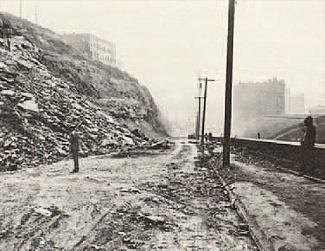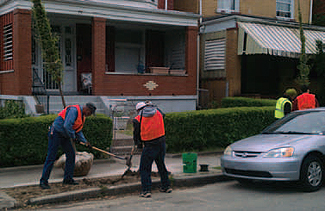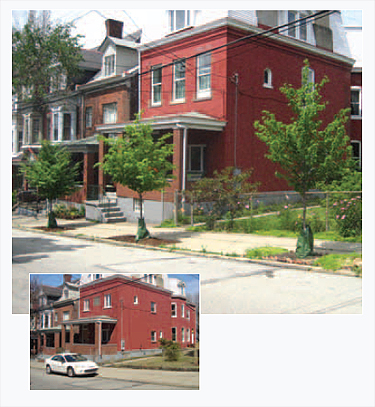WPC Continues its Legacy of Urban Forestry Work
The Western Pennsylvania Conservancy’s urban forestry work will reach a milestone this fall when it crosses the 15,000 mark for the number of trees planted in the greater Pittsburgh area since 2008. Even more significant than the number of trees is the impact they are having in neighborhoods.

WPC’s first-ever project involved planting trees as part of the restoration of this hillside along Bigelow Boulevard in 1940.
For example, WPC worked with Save Race Street Committee volunteers this spring to plant 25 trees along this Homewood street, advancing efforts they began in 2008 following an increase in violent crime there. Prior to that, trees had only been present along one block. “Long-term residents remember a tree-lined Race Street,” said Elwin Green, Save Race Street Committee chairman. “The new trees begin to restore the beauty it had when it was part of a prosperous and desirable community. That is a powerful memory to bring back.”
Less than three months after the trees were planted, four neighbors who had previously declined trees in front of their homes had approached Green requesting a tree. The trees add to the committee’s other improvement projects, which include installing raised flower beds, removing dead trees and unsightly underbrush from vacant lots, and repairing homes.
Urban forestry is in the Conservancy’s DNA. The organization’s very first on-the-ground project involved the planting of trees in an urban setting. In 1940, under its former name of the Greater Pittsburgh Parks Association, it restored a massive hillside and the area below it along Bigelow Boulevard that had been left barren and unsightly by a landslide.

WPC staff and neighborhood volunteers planted trees along Race Street in Pittsburgh’s Homewood area.
Photo courtesy of Elwin Green.
including producing oxygen, sheltering wildlife, decreasing energy usage, increasing property values and purifying the air. They are also good for commerce; shaded business districts have 11 percent more business than others. Pittsburgh’s street trees provide $2.4 million annually in economic and environmental benefits.
Another environmental benefit of urban trees is that their root systems and canopies help reduce erosion, flooding and storm water runoff. Tree canopies and the pits in which they are planted absorb storm water, slowing runoff and topsoil erosion and preventing urban pollutants from having a direct path to rivers. One moderately sized street tree can intercept 1,400 gallons of storm water annually; collectively Pittsburgh’s street trees help to manage over 40 million gallons of storm water annually.
However, while Pittsburgh prizes its high rankings on many livability indexes, one area with major room for improvement is the number of street trees per capita. The national average of one street tree for every three residents dwarfs Pittsburgh’s 1:11 ratio; in some neighborhoods like Homewood the ratio is a low as 1:22.
The city put forth substantial urban forestry efforts for nearly 100 years beginning in the 1880s with the passage of street tree protection laws. Efforts peaked from 1930 to 1960, thanks to a well-funded forestry department. However, support for trees declined dramatically—along with Pittsburgh’s economy—from 1980 to 1995, leading to a 30 percent decrease in the city’s street tree population. A 1995 report published by Carnegie Mellon University led to the reconstitution of the Shade Tree Commission and renewed focus on the issue.

Fisk Street in Pittsburgh’s Lawrenceville neighborhood, before and after WPC staff and volunteers planted street trees.
The problem was exacerbated by the low diversity of tree species. A 2005 street tree inventory revealed that almost 30 percent of the trees in Pittsburgh were some variety of maple. One pest such as the Asian longhorn beetle, which has decimated maple tree populations across the eastern seaboard, has the potential to wipe out nearly a third of the city’s trees. “Ideally we wouldn’t want any single species to make up more than 10 percent of our tree population; diversity will strengthen our urban forest,” said WPC’s Jeffery Bergman, Tree Vitalize Pittsburgh director.
The Conservancy’s current urban forestry initiative was launched in 2008 through TreeVitalize Pittsburgh, a collaborative project that is managed by the Conservancy. WPC and its partners, Allegheny County, the City of Pittsburgh, Tree Pittsburgh, and the Pennsylvania Department of Conservation and Natural Resources, will reach the goal of planting 20,000 trees throughout the Pittsburgh region by 2013. Additional goals for this initiative include decreasing the disparity in tree counts between neighborhoods (low-income neighborhoods have far fewer trees per capita than others) and improving public awareness about what it takes to keep street trees healthy.
The community has responded enthusiastically—to date, nearly 3,800 volunteers and 60 groups from 57 communities have joined the effort to add a total of more than 14,900 trees to streets, parks, trails and schoolyards in the greater Pittsburgh region. City and county parks have received a combined total of more than 4,000 trees, and over 2,000 of the trees have been planted on Mt. Washington.
The trees planted to date have a survival rate of 96.5%, attributable to committed and well-trained volunteers, and to the thorough site and tree selection process that includes on-site assessment and matching tree species to the conditions of each planting site.
To date, nearly 70 percent of all tree requests have been granted. At least two application workshops are held each year and take place in neighborhoods where trees are most needed. “It’s a great way to start the conversation about the value of trees and green infrastructure, and to explain the application process,” Bergman said.
WPC began accepting applications for trees from communities throughout Allegheny County in 2011. The first such project took place in the fall of 2011 in Scott Township, where virtually all of the trees in the township park were lost in a microburst storm.
This substantial increase in the region’s tree canopy would not have been possible without significant grants, including startup funding from The Heinz Endowments and the Pennsylvania Department of Conservation and Natural Resources and others from PennVest, Richard King Mellon Foundation and the Colcom Foundation. Support has also been provided by the Pittsburgh Foundation, Home Depot, Alcoa and FedEx.
